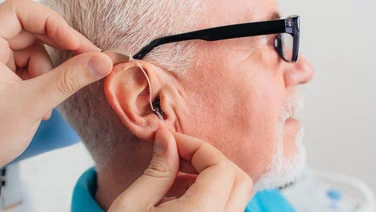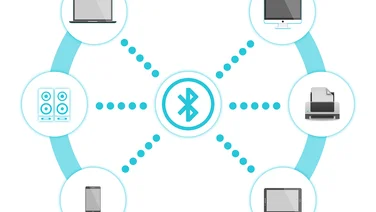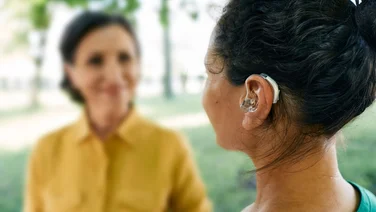Our content is funded in part by commercial partnerships, at no extra cost to you and without impact to our editorial impartiality.
A common and effective treatment for hearing loss is to wear a hearing aid. There are several types of hearing aids, and each one has its own benefits.
The best hearing aid for you will depend on many different factors, such as what kind of hearing loss you have and how it affects you. This decision should always be made during a consultation with a trained audiologist, but it’s important to understand the options available to you.
We can help you find out which hearing aid style will work for you
We'll match you with a local audiologist
What are hearing aids?
Hearing aids are very small electronic devices that sit in or around your ear to help you hear better.
They don’t fix your hearing, but they can make sounds louder and clearer. In addition being able to listen and hear more clearly in both noisy and quiet environments, you will be able to communicate with people more easily.
Only one in five people who would benefit from a hearing aid uses one. However, if you experience hearing loss, the chances are that a hearing aid will really make a difference in your everyday life.
How do hearing aids work?
Essentially, all types of hearing aids essentially work in the same way: to mimick the function of the auditory system.
Hearing aids are usually powered by small batteries, sometimes rechargeable batteries. They are made up of three main components:
- Microphone – this part of the hearing aid picks up sounds from the environment and converts them into electrical signals.
- Amplifier – this part takes those signals, processes and adjusts them, making them louder.
- Speaker (also called the receiver) – this part of the hearing aid receives the amplified signals as sound waves and sends them to your ears.
Hearing aid types
The different types and styles of hearing aids can be loosely grouped according to whether any of the components are housed in a casing that hooks over the top of the ear, or not.
The two main categories are behind-the-ear hearing aids and in-the-ear hearing aids.
Behind-the-ear (BTE) hearing aids

With this type of hearing aid, the electronic elements are contained in a plastic casing that hooks over the top of your ear and sits behind it.
-
Receiver in the ear (RITE) and receiver in canal (RIC)
This type of hearing aid also has a casing that sits behind your ear, which contains the microphone and amplifier components. The receiver (speaker) is positioned at the entrance to your ear.
-
Open-fit
This is similar to a RITE hearing aid, with the microphone and amplifier housed in a casing that hooks around your ear. The receiver (speaker) sits inside the case and is connected to very thin, narrow tubing, and fits inside your ear canal. The tubing enables the ear canal to stay open.
In-the-ear (ITE) hearing aids

With this type of hearing aid, there is no external casing that hooks around the top of your ear. Instead, all of the components of the hearing aid sit completely in the outer ear at various depths.
-
In the ear (ITE) full shell hearing aids
This type of hearing aid contains the electronic elements in a plastic casing that’s custom-made to fit the conchal bowl (also called the concha or bowl) of your outer ear.
-
In the ear (ITE) half shell hearing aids
This is a smaller version of the full shell ITE hearing aid, sitting just at the entrance to the ear canal so it’s less noticeable. Again, this type is custom-made to fit your ear.
-
In the canal (ITC) hearing aids
This type of hearing aid contains all the components in a very small plastic case, which is positioned in the entrance to the ear canal. These hearing aid types are custom-made to fit the size and shape of your ear canal.
-
Completely in the ear canal (CIC) hearing aids
These are similar to ITC hearing aids, but the tiny case is pushed into your ear canal. Like ITC aids, they are custom-made to fit each individual. They are unobtrusive and barely noticeable.
-
Invisible in the canal (IIC) hearing aids
As the name suggests, these discreet hearing aids cannot be seen from the outside because they sit deeper in the ear canal.

We can help you find out which hearing aid style will work for you
We'll match you with a local audiologist








